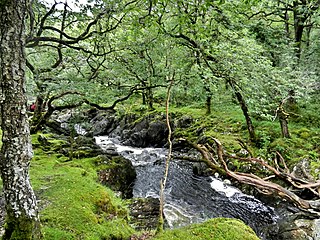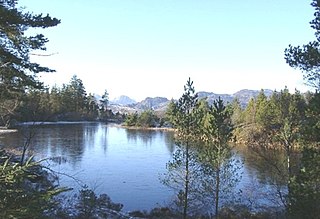Related Research Articles

Snowdonia, or Eryri, is a mountainous region and national park in North Wales. It contains all 15 mountains in Wales over 3000 feet high, including the country's highest, Snowdon, which is 1,085 metres (3,560 ft) tall. These peaks are all part of the Snowdon, Glyderau, and Carneddau ranges in the north of the region. The shorter Moelwynion and Moel Hebog ranges lie immediately to the south.
Plaid Cymru is a centre-left to left-wing, Welsh nationalist political party in Wales, committed to Welsh independence from the United Kingdom. It campaigns on a platform of social democracy and civic nationalism. The party is a supporter of the European Union and is a member of the European Free Alliance (EFA). The party holds 4 of 32 Welsh seats in the UK Parliament, 12 of 60 seats in the Senedd, and 202 of 1,231 principal local authority councillors. Plaid was formed in 1925 under the name Plaid Genedlaethol Cymru and Gwynfor Evans won the first Westminster seat for the party at the 1966 Carmarthen by-election.

Wales is a country that is part of the United Kingdom. It is bordered by the Irish Sea to the north and west, England to the east, the Bristol Channel to the south, and the Celtic Sea to the south-west. As of 2021, it had a population of 3.2 million. It has a total area of 21,218 square kilometres (8,192 sq mi) and over 2,700 kilometres (1,680 mi) of coastline. It is largely mountainous with its higher peaks in the north and central areas, including Snowdon, its highest summit. The country lies within the north temperate zone and has a changeable, maritime climate. Its capital and largest city is Cardiff.

The Countryside Council for Wales was a Welsh Assembly sponsored body responsible for wildlife conservation, landscape and countryside access in Wales.
The Forestry Commission is a non-ministerial government department responsible for the management of publicly owned forests and the regulation of both public and private forestry in England.

The River Conwy is a river in north Wales. From its source to its discharge in Conwy Bay it is 55 kilometres (34 mi) long and drains an area of 678 square km. "Conwy" was formerly anglicised as "Conway."

Environment Agency Wales was a Welsh Government sponsored body that was part of the Environment Agency of England and Wales from 1996 to 2013. Its principal aims were to protect and improve the environment in Wales and to promote sustainable development. On 1 April 2013 the organisation was merged with the Countryside Council for Wales and Forestry Commission Wales into a single environmental body, Natural Resources Wales.
Size of Wales is a climate change charity founded with the aim of conserving an area of tropical rainforest the size of Wales. The project currently supports seven forest protection projects and one tree planting project across Africa and South America. The charity focuses upon furthering the promotion of rainforest conservation as a national response to the global issue of climate change.
The Brechfa Forest is a forest in Carmarthenshire, south Wales. Brechfa Forest is the 'modern' name for part of the ancient Glyn Cothi Forest. From before records began in the 6th century the communities in the 15 villages which encircle Glyn Cothi Forest were managing it to provide employment, building materials, products, and grazing. At various times the forest has been the refuge of Welsh Princes fighting the Norman Invasion, a Royal Hunting Forest, and for two centuries was the 'Texas' of Wales, producing large quantities of oil for lamps. and was a major supplier of timber for the trenches and explosives during World War One.
Brechfa, situated between Llandeilo and Carmarthen in the county of Carmarthenshire, Wales, is a village that has existed since the 6th century at the top of the Cothi Valley. Brechfa village is set in countryside, as well as being located by the Brechfa Forest

The United Kingdom, being in the British Isles, is ideal for tree growth, thanks to its mild winters, plentiful rainfall, fertile soil and hill-sheltered topography. In the absence of people, much of Great Britain would be covered with mature oaks as well as savannah-type of plains, except for Scotland. Although conditions for forestry are good, trees face threats from fungi, parasites and pests. Nowadays, about 13% of Britain's land surface is wooded. European countries average 39%, but this varies widely from 1% (Malta) to 66% (Finland). As of 2021, government plans call for 30,000 hectares to be reforested each year. Efforts to reach these targets have attracted criticism for planting non-native trees, or trees that are out of place for their surroundings, leading to ecological changes.

Scotland is ideal for tree growth, thanks to its mild winters, plentiful rainfall, fertile soil and hill-sheltered topography. As of 2019 about 18.5% of the country was wooded. Although this figure is well below the European Union (EU) average of 43%, it represents a significant increase compared to the figure of 100 years previously: in 1919 it was estimated that only 5% of the country's total land area was covered in forest. The Scottish Government's Draft Climate Change Plan has set an aim of increasing coverage to 21% of Scotland by 2032, with the rate of afforestation rising to 15,000 hectares per year by 2024.

Natural Resources Wales is a Welsh Government sponsored body, which became operational from 1 April 2013, when it took over the management of the natural resources of Wales. It was formed from a merger of the Countryside Council for Wales, Environment Agency Wales, and the Forestry Commission Wales, and also assumed some other roles formerly performed by the Welsh Government.
Wales has a surface area of 2,628,779 km2 or 2,077,900 ha. It has a border with England to the east, and is bounded by the Irish Sea to the north and west, and by the Bristol Channel to the south. It has an oceanic temperate climate which is markedly influenced by the North Atlantic Current carrying warm water from tropical latitudes. As a result, it has a much milder climate than most places in the world at similar latitudes. Altitudes range from sea-level to 10985 m on the Snowdon Massif.

Dolmelynllyn Estate is an area of farmland, woodland and parkland near the village of Ganllwyd in southern Gwynedd, Wales. It is owned by the National Trust. The estate was formerly owned by William Madocks, the architect of Porthmadog. Features of the estate include ancient woodland, temperate rainforest, rare lichens and mosses, as well as archaeological features from prehistoric cists to nineteenth-century gold mines. The estate also has 46 bee boles on it, which is the highest concentration in the United Kingdom.

Welsh devolution is the transfer of legislative powers for self-governance to Wales by the Parliament of the United Kingdom. The current system of devolution began following the enactment of the Government of Wales Act 1998, with the responsibility of various devolved powers granted to the Welsh Government rather than being the responsibility of the Government of the United Kingdom.

The National Forest for Wales is a long-term forestation programme by the Welsh Government, aiming to form a network of woodland throughout Wales.

There are various areas of temperate rainforests in Wales, also termed a "Celtic rainforest". They are located largely in river valleys, adjacent to the sea, on Wales' western coasts, particularly in Snowdonia (Eryri), Powys and Ceredigion.

Trydan Gwyrdd Cymru is a publicly-owned renewable energy developer established by the Welsh Government in March 2024 and launched in July 2024. The company is tasked with aiding the development of renewable energy projects, particularly focusing on onshore wind, across the Welsh public estate.
References
- ↑ "Role of Natural Resources Wales". LawWales. Archived from the original on 12 February 2017. Retrieved 4 March 2021.
- ↑ "Welsh Government-Natural Resources Wales". 9 April 2013. Archived from the original on 31 May 2014. Retrieved 27 July 2015.
- ↑ "The National Forest for Wales". Wales. 2022-02-01. Retrieved 2022-06-27.
- ↑ "Welsh Government - Natural Resources Wales". wales.gov.uk. 9 April 2013. Archived from the original on 2014-05-31. Retrieved 2015-07-27.
- ↑ "Coed Cymru".
- ↑ "Woodknowledge Wales". Archived from the original on 2017-10-15. Retrieved 2019-01-27.